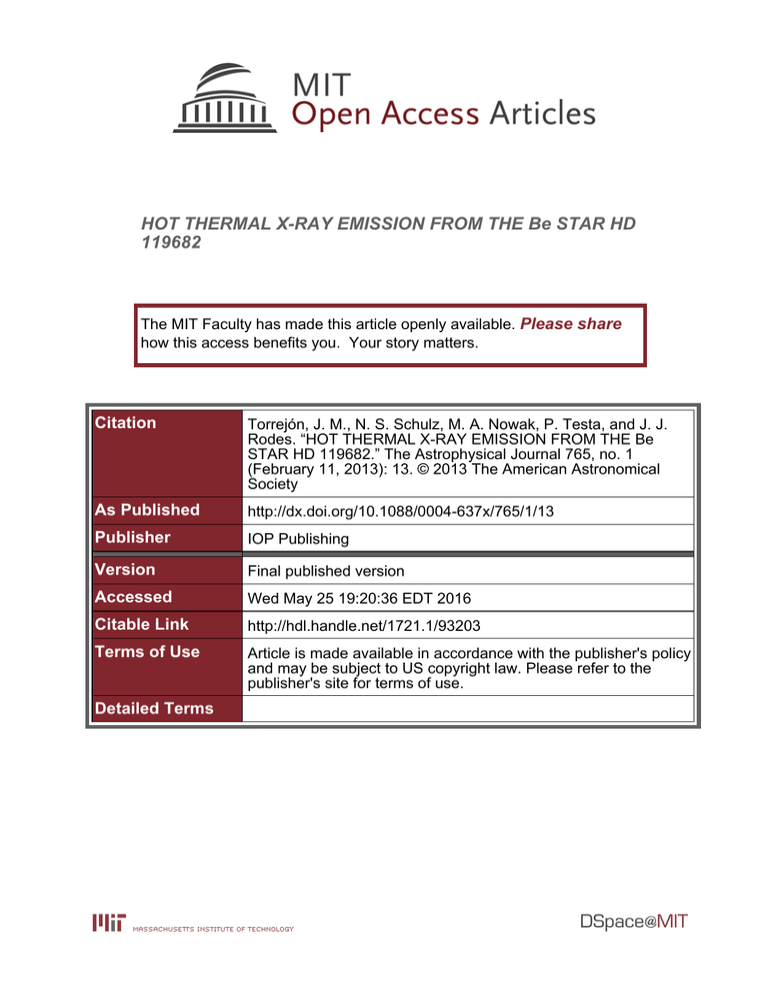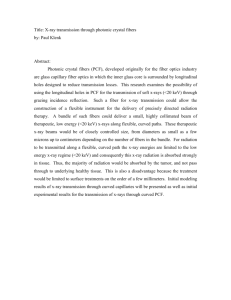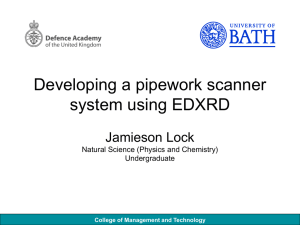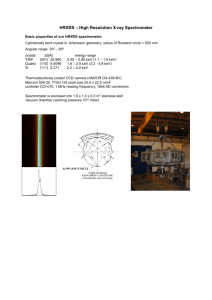HOT THERMAL X-RAY EMISSION FROM THE Be STAR HD 119682 Please share
advertisement

HOT THERMAL X-RAY EMISSION FROM THE Be STAR HD 119682 The MIT Faculty has made this article openly available. Please share how this access benefits you. Your story matters. Citation Torrejón, J. M., N. S. Schulz, M. A. Nowak, P. Testa, and J. J. Rodes. “HOT THERMAL X-RAY EMISSION FROM THE Be STAR HD 119682.” The Astrophysical Journal 765, no. 1 (February 11, 2013): 13. © 2013 The American Astronomical Society As Published http://dx.doi.org/10.1088/0004-637x/765/1/13 Publisher IOP Publishing Version Final published version Accessed Wed May 25 19:20:36 EDT 2016 Citable Link http://hdl.handle.net/1721.1/93203 Terms of Use Article is made available in accordance with the publisher's policy and may be subject to US copyright law. Please refer to the publisher's site for terms of use. Detailed Terms The Astrophysical Journal, 765:13 (5pp), 2013 March 1 C 2013. doi:10.1088/0004-637X/765/1/13 The American Astronomical Society. All rights reserved. Printed in the U.S.A. HOT THERMAL X-RAY EMISSION FROM THE Be STAR HD 119682 1 J. M. Torrejón1 , N. S. Schulz2 , M. A. Nowak2 , P. Testa3 , and J. J. Rodes1 Instituto Universitario de Fı́sica Aplicada a las Ciencias y las Tecnologı́as, Universidad de Alicante, E-03080 Alicante, Spain; jmt@ua.es 2 MIT Kavli Institute for Astrophysics and Space Research, Cambridge, MA 02139, USA 3 Harvard-Smithsonian Center for Astrophysics, Cambridge, MA 02138, USA Received 2012 July 30; accepted 2013 January 10; published 2013 February 11 ABSTRACT We present an analysis of a series of four consecutive Chandra high-resolution transmission gratings observations, amounting to a total of 150 ks, of the Be X-ray source HD 119682 (=1WGA J1346.5−6255), a member of the new class of γ Cas analogs. The Chandra light curve shows significant brightness variations on timescales of hours. However, the spectral distribution appears rather stable within each observation and during the whole campaign. A detailed analysis is not able to detect any coherent pulsation up to a frequency of 0.05 Hz. The Chandra High Energy Transmission Gratings spectrum seems to be devoid of any strong emission line, including Fe Kα fluorescence. The continuum is well described with the addition of two collisionally ionized plasmas of temperatures kT ≈ 15 keV and 0.2 keV, respectively, by the apec model. Models using photoionized plasma components (mekal) or non-thermal components (powerlaw) give poorer fits, providing support for the pure thermal scenario. These two components 22 are absorbed by a single column with NH = (0.20+0.15 cm−2 compatible with the interstellar value. We −0.03 ) × 10 conclude that HD 119682 can be regarded as a pole-on γ Cas analog. Key words: stars: individual (HD 119682) – X-rays: binaries Online-only material: color figures satisfactorily described by the addition of two optically thin thermal plasmas, using the mekal model, with kT1 = 1.7 ± 0.3 keV and kT2 = 13.0+2.6 −2.4 keV, respectively, while the fit to the Chandra spectrum, extracted from the S3 ACIS CCD chip, delivers temperatures of kT1 = 0.95+0.34 −0.24 keV and kT2 14 keV, respectively. Alternatively, the hotter thermal component can be described by a power law. This degeneracy has also been found in γ Cas (Smith et al. 2004; Lopes de Oliveira et al. 2010) and HD 110432 (Lopes de Oliveira et al. 2007; Torrejón et al. 2012). S07 also present hints of a possible pulsation with P 1500 s that could be caused by the spin of a neutron star (NS) or a white dwarf (WD). The origin of the X-ray emission in γ Cas analogs is still a mystery. Two hypotheses have been put forward. 1. INTRODUCTION HD 119682 (1WGA J1346.5−6255) is a Be star that presents copious X-ray emission. It is a member of the open cluster NGC 5281, located at a distance of ∼1.3 kpc, and it displays an X-ray luminosity in the 0.5–10 keV energy band of the order of LX ∼ 1032 erg s−1 , which is low when compared with the typical luminosities of Be X-ray binaries (LX ∼ 1036 –1037 erg s−1 ), two orders of magnitude lower than persistent Be X-ray binaries (Reig & Roche 1999), and at least one order of magnitude higher than the expected X-ray emission from isolated OB stars (Berghöfer et al. 1997). With a mass of M = 18 ± 1 M and an age of 4 ± 1 Myr, HD 119682 seems to be a blue straggler (Marco et al. 2009), the second (out of the seven known) gamma Cas analog that shares this property. Rakowski et al. (2006, hereafter R06), using the superb spatial resolution of Chandra as well as Hα images from the Clay 6.5 m Telescope in the Magellan Observatory at Las Campanas, unambiguously identified the X-ray source 1WGA J1346.5−6255 with the OB star HD 119682. Using XMM-Newton PN+MOS data, these authors showed that the X-ray spectrum is well described by the addition of two optically thin (raymond) thermal plasmas with kT1 = 1.07±0.16 keV and kT2 = 10.4+2.3 −1.6 keV, respectively. Based on the similarities shared between HD 119682 and γ Cas (early-type optical counterpart, thermal nature of the X-ray emission, log LX /Lbol = −5.4, etc.), R06 classify the source as a γ Cas analog and argue against other X-ray production mechanisms such as colliding winds (with an unseen companion) or emission from a magnetically confined wind (given the very high temperature of the hot plasma). Safi-Harb et al. (2007, hereafter S07), in a multifrequency analysis, confirm the identification between 1WGA J1346.5−6255 and HD 119682 and characterize the optical counterpart (B0.5Ve), definitely showing that this source is unrelated to the background supernova remnant G309.2–00.6. These authors find that the XMM-Newton PN+MOS data can be 1. The first is the X-ray binary scenario, in which a WD accretes matter from the Be donor (Haberl 1995; Kubo et al. 1998; Owens et al. 1999 for the case of γ Cas; Torrejón & Orr 2001 for the case of HD 110432). The low potential well of the WD, compared with that of an NS, accounts naturally for the lower luminosity and the thermal nature of the X-ray emission. This explanation faces several problems. On one hand, the X-ray emission shows no sign of any orbital modulation or spin pulse. On the other hand, the progenitor of the putative WD should still have been more massive than the early B companion (M ∼ 20 M ). From the evolutionary perspective, it is challenging to produce a WD from such a massive star; naturally, they would explode as a supernova leaving behind an NS, as is the case for the Be X-ray binaries. In the case of HD 119682, no SN explosion seems to have occurred (Marco et al. 2009), which argues against the NS companion. 2. The second is the stand-alone star scenario, in which the X-rays are produced by the interaction of the star’s magnetic field with the circumstellar disk (Robinson et al. 2002; Robinson & Smith 2000; Smith et al. 2004). In this scenario, magnetorotational instabilities in the inner part 1 The Astrophysical Journal, 765:13 (5pp), 2013 March 1 Torrejón et al. 2000). The photoelectric absorption has been treated with the tbnew absorption model (J. Wilms et al. 2012, in preparation)5 , which includes the most up-to-date photoelectric cross sections. Table 1 Journal of Chandra HETG Observations ObsID Date (dd-mm-yyyy) texp (ks) Ratea (counts s−1 ) 8929 10835 10834 10836 2008 Dec 17 00:20:10 2008 Dec 19 09:32:42 2008 Dec 20 15:45:04 2008 Dec 21 15:47:03 28.9 29.7 59.3 29.9 0.039 0.031 0.032 0.035 3. TIMING ANALYSIS The four observations analyzed in this work span five different days with uninterrupted coverages ranging from 30 ks to 60 ks. In total, they represent 150 ks worth of data. This allows us to search for coherent pulsations over a wide range of frequencies with unprecedented detail. In the left panel of Figure 1, we present the Chandra light curve binned to 2000 s bins. As can be seen, the source brightness is variable on timescales shorter than the duration of a single observation (ObsID). During the whole campaign, however, the source remains quite stable. In order to search for coherent pulsations, we have analyzed the light curve with a maximum time resolution of 10 s. Subsequently, we have created light curves with larger time bins of 100, 250, and 500 s to reduce the error bars. In Figure 1, right panel, we show as an example the normalized fast Fourier transform periodogram of the light curve using 250 s bins, using the Lomb–Scargle technique, for each ObsID. The upper plot corresponds to all four intervals together, taking into account the duration of the time gaps between each observation. S07 suggested the possibility of a ∼1500 s pulsation in the light curve of HD 119682. In our last ObsID (10386), there is indeed a peak at P = 1443 ± 17 s (and also other at 2350 ± 50 s). The significance of this peak, as given by the false alarm probability (FAP), is low. FAP is defined as the probability that no periodic component is present in the data with such a period within the current frequency search parameters. In order to compute this significance, we have run 103 Monte Carlo simulations of the randomized Y-axis values of the light curve and performed the corresponding periodograms. Then, we search for peaks higher than that in the original periodogram at any frequency. We have found higher peaks in 20% ± 3% (2σ standard error) of the periodograms. Therefore, the FAP is rather high, ∼20%, and, consequently, the significance of the peak is low. Similar results are obtained irrespective of the size of the time bin. However, neither of these peaks are present in the previous data sets. Although some low significance peaks can be seen in each periodogram, none of them remain stable. Consequently, in the whole data set, we do not find evidence of any significant period up to a frequency of 0.05 mHz6 . In order to study the spectral variations of the X-ray source, we have extracted the Chandra light curves in the wavelength intervals 3–6 keV (H), 2–3 keV (M), and 0.5–2 keV (S), and have created the corresponding hardness ratios versus source intensity plots. In Figure 2, we show the variation of the hardness ratio against the source intensity (0.5–6 keV) using 7000 s time bins. As can be seen, the source does not show any spectral correlation with brightness. The average values of the hardness ratios are 0.43 ± 0.07 (ObsID 8929), 0.48 ± 0.07 (ObsID 10835), 0.53 ± 0.06 (ObsID 10834), and 0.50 ± 0.06 (ObsID 10836). They are, therefore, compatible within errors. The differences between single values of the hardness ratio are not significant either. Individual errors range between 0.15 and 0.20. In conclusion, while changes in brightness from bin to bin are significant overall the hardness ratios are consistent with a Note. a Zeroth order. of the circumstellar disk around the Be star (close to the Keplerian corotation radius) enhance a seed magnetic field through a disk dynamo mechanism (Balbus & Hawley, 1998). The differential rotation of the disk stretches the entangled field lines, which eventually sever accelerating particles which, upon impact with the star’s surface, heat the plasma up to MK temperatures. The finding that the X-ray emission seems to be produced close to the surface of the Be star supports this scenario (Smith et al. 2012; Torrejón et al. 2012). The details of this mechanism, though, are far from clear. Why other early-type Be stars with large circumstellar disks do not produce X-ray emission at all is not explained. In any case, understanding the true nature of these systems will have important consequences on our picture of the structure and evolution of early-type stars and/or how binary systems evolve. In this work, we present an analysis of a series of four consecutive Chandra High Energy Transmission Gratings (HETG) observations of the Be star HD 119682, allowing us to study the spectrum at the highest resolution available today. The four observations amount to a total of ∼150 ks, spread over five days, allowing a sensitive search for pulsations in a wide range of frequencies. 2. OBSERVATIONS We have processed and analyzed the Chandra data from the ObsIDs 8929, 10835, 10834, and 10836 available at the public archive (PI: C. E. Rakowski). In Table 1, we show the journal of observations. The Chandra HETG spectrometer (Canizares et al. 2005) observed the source during 150 ks, split into four intervals. Both HETG instruments, the High Energy Gratings (HEG; 0.7–8 keV) and Medium Energy Gratings (MEG; 0.4–8 keV), were used for the analysis. After filtering the data, the 0.5–7.5 keV spectral range showed enough signal-tonoise ratio (S/N) for the scientific analysis. Both the spectra and the response files (arf and rmf) were extracted using the CIAO software (v 4.4). First dispersion orders (m = ±1) were fitted simultaneously. The extracted spectra were binned to match the resolution of HEG (0.012 Å FWHM) and MEG (0.023 Å FWHM) and have a minimum S/N of 7. The peak count rate in a single (MEG) gratings arm spectrum is ≈0.008 counts s−1 Å−1 and, consequently, the spectra are not affected by pileup.4 For the light-curve extractions, we add data from all of the dispersed orders (m = −3, −2, −1, 1, 2, 3) from HEG and MEG. High dispersion orders (m = ±3, ±2) constitute 25% of the total count rate. The analysis was performed with the Interactive Spectral Interpretation System (ISIS) v 1.6.1-24 (Houck & Denicola 5 Available online at http://pulsar.sternwarte.uni-erlangen.de/wilms/research/tbabs/. 6 The Nyquist frequency corresponding to the 10 s time bin. 4 See The Chandra ABC Guide to Pileup, v.2.2, http://cxc.harvard.edu/ciao/download/doc/pileup-abc.pdf. 2 Torrejón et al. 0.1 The Astrophysical Journal, 765:13 (5pp), 2013 March 1 10834 5×104 105 Time (s) 10836 0.05 10835 0 c/s 8929 0 1.5×105 0 5 5×10−5 10−4 2×10−4 5×10−4 0.5 0.02 0.03 0.04 Counts/s 0.05 kT=0.20 keV kT=15.7 keV −5 0 χ (S − H)/(S + H) 0.2 0.4 0.6 0.8 Photons cm2/s/keV 1 Figure 1. Left: Chandra light curve, in the 2–25 Å wavelength range, binned in 2000 s intervals. All of the light curves have an arbitrary time offset and, therefore, the time gaps are not to scale. Right: power spectrum corresponding to the 250 s binned Chandra HETG light curve. The 1500 s pulsation (ν 6.7 × 10−4 Hz) is only detected in ObsID 10836, but is not detected either in the rest of the ObsIDs or in the combined ligth curve. (A color version of this figure is available in the online journal.) 1 2 Energy (keV) 5 Figure 3. Chandra HETG unfolded spectrum of HD 119682 showing the relative contributions of the low- and high-temperature plasmas, respectively. Also shown (in red) is the best-fit model. (A color version of this figure is available in the online journal.) Figure 2. Chandra hardness–intensity plot using 7000 s time bins. Different colors represent the different ObsIDs, with the same color coding as in Figure 1. While changes in brightness from bin to bin are, in general, significant, the hardness ratios are consistent with a constant value. (A color version of this figure is available in the online journal.) In order to describe the continuum, models consisting of one component do not give satisfactory results. For example, an absorbed powerlaw gives a reduced chi square χr2 = 1.71 for 88 degrees of freedom (dof), while a single mekal gives χr2 = 1.64 (88 dof). The spectrum always shows a pronounced excess below 1 keV which can only be modeled when a second component to the model is added. The best fit is attained with the addition of two optically thin collisionally ionized plasmas (apec). The parameters are shown in the fourth column of Table 2. The low energy range is fitted by a plasma with kT = 0.20+0.03 −0.02 keV and solar abundance. The high sensitivity of the Chandra gratings allows us to constrain this temperature constant value. The source appears rather monochromatic on timescales from hours to days. 4. SPECTRAL ANALYSIS According to the previous analysis, the spectra of HD 119682 are fairly stable in a timescale of days despite the variations in the brightness. Therefore, we have combined the four observations into a single spectrum to increase the S/N. The resulting spectrum is shown in Figure 3. 3 The Astrophysical Journal, 765:13 (5pp), 2013 March 1 Torrejón et al. Table 2 Model Parameters for Chandra HETG Data shown that the different spectral components are affected by different absorption columns (Smith et al. 2004 for γ Cas; Lopes de Oliveira et al. 2007 and Torrejón et al. 2012 for HD 110432). Here, we have tried the same strategy. The values of the resulting columns turn out to be identical, within the errors, for all of the models. Therefore, a single photoelectric absorption satisfactorily describes the spectrum of HD 119682. 22 The measured NH = (0.20+0.15 cm−2 is very low, in −0.03 ) × 10 agreement with R06 and S07. Component powerlaw apec 1 apec 2 Parameter Value PL+APEC 2 APEC NH a 0.15+0.15 −0.03 0.20+0.15 −0.03 Norm ··· Γ 0.00026+0.0005 −0.0004 1.36+0.15 −0.01 Norm ··· kT (keV) ··· 0.0018+0.0005 −0.0006 Norm 0.0003+0.0003 −0.0001 0.21+0.02 −0.03 kT (keV) Fluxb χr2 (dof) 1.78 1.48 (86) ··· 15.7+4.7 −5.4 0.0005+0.0001 −0.0002 5. DISCUSSION 0.20+0.03 −0.02 1.81 1.35 (86) The spectrum of HD 119682 differs from other γ Cas analogs observed at high resolution mainly in that it shows no discernible emission lines. Particularly striking is the fact that no Fe complex is observed. Despite this, the continuum spectral parameters of HD 119682 are very similar to those of γ Cas (Smith et al. 2004, Figure 2) and HD 110432 (Torrejón et al. 2012). Consistent with these previous works, the correct description of the spectrum is attained with the addition of several thermal components. In the case of HD 119682, only two are needed with characteristic temperatures in the ∼2 MK and ∼150 MK range. Both components are modified by a single absorption column NHX ∼ 0.20×1022 cm−2 . This column would imply an interstellar excess E(B − V ) = NHX /6.83 × 1021 = 7 0.29+0.03 −0.01 (Ryter 1996) , in good agreement with the interstellar medium (ISM) absorption toward NGC 5281 (Moffat & Vogt 1973, E(B − V ) = 0.26 ± 0.03; Marco et al. 2009, E(B − V ) = 0.28 ± 0.02). HD 119682 has been observed several times both in X-rays (XMM-Newton 2001 August and Chandra 2004 December, R06, S07; 2008 December, this work) and in the Hα light (2003 June and 2004 February; R06, S07), always showing a strong emission. Although the time coverage is still poor, the source appears to be persistent in both energy bands. Assuming that the circumstellar envelope (and hence the Hα emission) was also present at the epoch of our Chandra observation, the X-ray source was not obscured by the disk material. The same would be true for the observations analyzed in previous works (R06; S07). The circumstellar disk (confined to the equatorial plane) does not intercept the X-ray emission. In the framework of the accreting binary system, the compact object (the WD) should not be deeply embedded into the circumstellar disk; yet it should be accreting enough material to persistently power the X-ray source up to a non-negligible LX ∼ 3.8 × 1032 erg s−1 . This would require a very special tuning of the astrophysical parameters of the system. However, even though it is rare, this situation can happen: 4U2206 + 54 is a low-luminosity (LX ≈ 1035 –1036 erg s−1 ) high-mass X-ray binary with an NS accreting from the wind of a massive O9.5V star, while the X-ray spectrum presents very few (if any) local absorption (Reig et al. 2012). Contrary to the case of 4U2206 + 54, however, no pulsations have been found for HD 119682 or any other γ Cas analog so far. In contrast, within the framework of the standalone active star, the single absorption column, compatible with the ISM value, can be simply understood if the system is seen at very high inclination angles. It has been recently found that the hard X-ray component of the multi-thermal emission of γ Cas (Smith et al. 2012) and HD 110432 (Torrejón et al. 2012) is very likely produced near the surface of the Be star and is absorbed by material with a column density compatible with Notes. a In units of ×1022 cm−2 . b Unabsorbed 0.5–8 keV flux in units of ×10−12 erg s−1 cm−2 . with unprecedented accuracy. Although there are few energy bins below 1 keV, the associated errors (blue crosses) are very small. The obtained plasma temperature kT2 = 0.20+0.03 −0.02 keV is fully compatible with the temperature of the cool plasma in HD 110432 derived from high-resolution spectra (Torrejón et al. 2012) and significantly lower than that obtained by R06 (kT = 1.07 ± 0.16 keV; Raymond–Smith) and S07 (kT = 1.7 ± 0.3 keV; mekal). The absorption column, however, remains essentially compatible (see below). Therefore, the differences in kT could be due to intrinsic long-term variability of the source. This variability in the cool plasma temperature seems also to be present in γ Cas (Lopes de Oliveira et al. 2010), while the hot plasma temperature appears to be more stable. The high energy range requires a second, much hotter apec model with kT = 15.7+4.7 −5.4 keV. This temperature is compatible within errors with that derived by R06 and S07. Alternatively, in agreement with previous works on γ Cas candidates, the high energy range can be fit with a powerlaw with a photon index Γ = 1.36. The parameters are shown in the third column of Table 2. However, in terms of χ 2 , the two apec models are significantly better. Replacing the collisionally ionized plasmas (apec) by photoionized plasmas (mekal) gives slightly worse fits. For example, the two mekal models give χr2 = 1.38 (86 dof), while powerlaw + mekal gives χr2 = 1.49 (86 dof). In conclusion, the fully thermal model composed by two apec components is favored by the present data set. The most conspicuous characteristic of the spectrum is the lack of any discernible emission line. In particular, no Fe Kα line is seen and even the flux at 6 keV is below the 7σ level. There is flux up to 7 keV at the 3σ level; however, there is certainly not an Fe emission line even at 1σ . Finally, the residuals present some structures between 1 and 2 keV that could be due to the presence of emission lines. Indeed, this is the line-rich region for highly ionized plasmas. The HETG spectra of bright γ Cas analogs display several strong emission lines in this region (Smith et al. 2004, Figure 2, for γ Cas; Torrejón et al. 2012, Figures 7 and 8, for HD 110432). Strong lines of Ne x Lyα (1.02 keV) and Si xiv Lyα (2.00 keV) as well as weaker lines of Fe xxiv (1.17 keV) and Mg xii Lyα (1.47 keV) might be expected in this area. However, none of these lines show up in the spectrum of HD 119682 with equivalent width (EW) upper limits of the order of 1 eV. The high sensitivity of Chandra HETG at low energies also allows us to study the absorption column with unprecedented detail. The analysis of brighter members of this class has 7 4 The errors represent the propagated uncertainty in the measured NHX . The Astrophysical Journal, 765:13 (5pp), 2013 March 1 Torrejón et al. the circumstellar disk. If this is also correct for HD 119682, then the NHX ≈ NHISM implies that the system must be observed at high inclination. This would be consistent with the single-peaked emission lines seen in the optical spectrum of this object (S07). R06 and S07 report hints of Fe Kα emission. However, no sign of such emission line (nor any other) is present here. Thus, the fluorescence emission from neutral Fe seems to be variable in the long term. On the other hand, the 0.5–8.5 keV X-ray luminosity of the source has varied within a maximum factor of ∼2 in a period of 7 years (R06; S07; this work). One of the possible sites for the Kα reprocessing of the X-rays is the circumstellar disk. Smith et al. (2012) find a direct correlation between the absorption column of the hard emission and the EW (Fe Kα, as well as with the reddening) for γ Cas (Table 5 of that reference), implying that most, perhaps all, of the X-ray emission is produced behind the circumstellar disk material. These authors also deduced an inclination of i = [43 ± 1]◦ for γ Cas. In the case of HD 119682, however, the absorption column remains always compatible with the ISM value despite the changes in the X-ray brightness of the source and variable Fe Kα emission because the circumstellar disk, confined to the equatorial plane, never intercepts the X-ray emission. HD 119682 would thus appear as a pole-on γ Cas, an important benchmark to explore the phenomenon where the plasma, and its variations, could be directly observed without any intervening circumstellar material. Spanish Ministerio de Ciencia e Innovación (MICINN) through the grants AYA2010-15431 and AIB2010DE-00057. REFERENCES Balbus, S. A., & Hawley, J. F. 1998, RvMP, 70, 1 Berghöfer, T. W., Schmitt, J. H. M. M., Danner, R., & Cassinelli, J. P. 1997, A&A, 322, 167 Canizares, C., Davis, J. E., Dewey, D., et al. 2005, PASP, 117, 1144 Haberl, F. 1995, A&A, 296, 685 Houck, J. C., & Denicola, L. A. 2000, in ASP Conf. Ser. 216, Astronomical Data Analysis Software and Systems IX, ed. N. Manset, C. Veillet, & D. Crabtree (San Francisco, CA: ASP), 591 Kubo, S., Murakami, T., Ishida, M., & Corbet, R. H. D. 1998, PASJ, 50, 417 Lopes de Oliveira, R., Motch, C., Smith, M., Negueruela, I., & Torrejón, J. M. 2007, A&A, 474, 983 (LO07) Lopes de Oliveira, R., Smith, M., & Motch, C. 2010, A&A, 512, A22 Marco, A., Negueruela, I., Ribó, M., Lorenzo, J., & Motch, C. 2009, AdSpR, 44, 348 Moffat, A. F. J., & Vogt, N. 1973, A&AS, 10, 135 Owens, A., Oosterbroek, T., Parmar, A. N., Stüwe, J. A., & Haberl, F. 1999, A&A, 348, 170 Rakowski, C. E., Schulz, N. S., Wolk, S. J., & Testa, P. 2006, ApJ, 649, 111 (R06) Reig, P., & Roche, P. 1999, MNRAS, 306, 100 Reig, P., Torrejón, J. M., & Blay, P. 2012, MNRAS, 425, 595 Robinson, R. D., & Smith, M. A. 2000, ApJ, 540, 474 Robinson, R. D., Smith, M., & Henry, G. W. 2002, ApJ, 575, 435 Ryter, Ch. E. 1996, Ap&SS, 236, 285 Safi-Harb, S., Ribó, M., Butt, Y., et al. 2007, ApJ, 659, 407 (S07) Smith, M., Cohen, D. H., Gu, M. F., et al. 2004, ApJ, 600, 972 Smith, M., Lopes de Oliveira, R., Motch, C., et al. 2012, A&A, 540, A53 Torrejón, J. M., & Orr, A. 2001, A&A, 377, 148 Torrejón, J. M., Schulz, N. S., & Nowak, M. A. 2012, ApJ, 750, 75 The authors acknowledge the constructive criticism of an anonymous referee. This work has been supported by the 5







